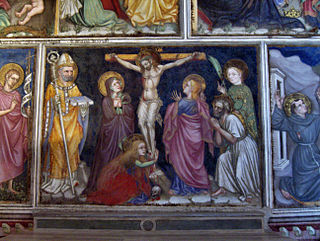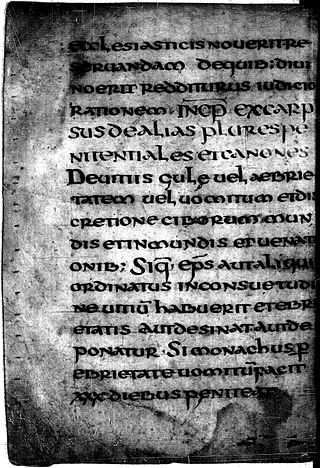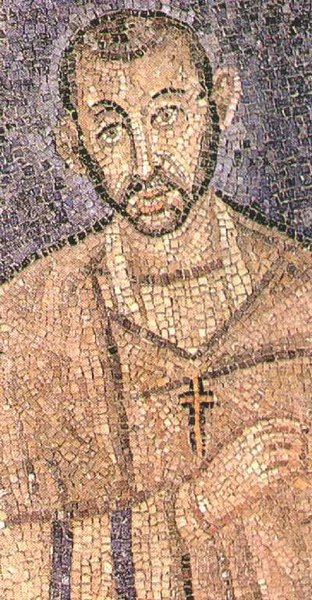Related Research Articles

Pope Boniface IX was head of the Catholic Church from 2 November 1389 to his death, in October 1404. He was the second Roman pope of the Western Schism. During this time the Avignon claimants, Clement VII and Benedict XIII, maintained the Roman Curia in Avignon, under the protection of the French monarchy. He is the last pope to date to take on the pontifical name "Boniface".

Boniface, OSB was an English Benedictine monk and leading figure in the Anglo-Saxon mission to the Germanic parts of Francia during the eighth century. He organised significant foundations of the church in Germany and was made bishop of Mainz by Pope Gregory III. He was martyred in Frisia in 754, along with 52 others, and his remains were returned to Fulda, where they rest in a sarcophagus which remains a site of Christian pilgrimage.

Jacobus de Voragine was an Italian chronicler and archbishop of Genoa. He was the author, or more accurately the compiler, of the Golden Legend, a collection of the legendary lives of the greater saints of the medieval church that was one of the most popular religious works of the Middle Ages.
The Concilium Germanicum was the first major Church synod to be held in the eastern parts of the Frankish kingdoms. It was called by Carloman on 21 April 742/743 at an unknown location, and presided over by Boniface, who was solidified in his position as leader of the Austrasian church. German historian Gunther Wolf judges that the Concilium was the high point in Boniface's long career.

The Büraburg was a prominent hill castle with historic significance, on the Büraberg hill overlooking the Eder river near the town of Fritzlar in northern Hesse (Germany). Only foundation walls remain, and a church dedicated to St. Brigida.

Donar's Oak was a sacred tree of the Germanic pagans located in an unclear location around what is now the region of Hesse, Germany. According to the 8th century Vita Bonifatii auctore Willibaldo, the Anglo-Saxon missionary Saint Boniface and his retinue cut down the tree earlier in the same century. Wood from the oak was then reportedly used to build a church at the site dedicated to Saint Peter. Sacred trees and sacred groves were widely venerated by the Germanic peoples.
A homiliarium or homiliary is a collection of homilies, or familiar explanations of the Gospels.
Collections of ancient canons contain collected bodies of canon law that originated in various documents, such as papal and synodal decisions, and that can be designated by the generic term of canons.
The mythology of the modern-day Netherlands, Belgium and Luxembourg has its roots in the mythologies of pre-Christian cultures, predating the region's Christianization under the influence of the Franks in the Early Middle Ages. At the time of the Roman Empire and in the Early Middle Ages, some of the resident peoples of the Low Countries' included:
The eighth-century Codex Eyckensis is a Gospel Book based on two constituent manuscripts that were bound as a single codex from (presumably) the twelfth century until 1988. The Codex Eyckensis is the oldest book in Belgium. Since the eighth century it has been kept and preserved on the territory of the present-day municipality of Maaseik, in Belgium. The book was probably produced in the scriptorium in the Abbey of Echternach. It is housed in the church of St Catherine in Maaseik.

The Frisian Kingdom, also known as Magna Frisia, is a modern name for the post-Roman Frisian realm in Western Europe in the period when it was at its largest (650–734). This dominion was ruled by kings and emerged in the mid-7th century and probably ended with the Battle of the Boarn in 734 when the Frisians were defeated by the Frankish Empire. It lay mainly in what is now the Netherlands and – according to some 19th century authors – extended from the Zwin near Bruges in Belgium to the Weser in Germany. The center of power was the city of Utrecht.

Ignace Michiels is a Belgian organist, choral conductor and organ teacher. He is internationally known as a concert organist.
The Codex Vindobonensis 751, also known as the Vienna Boniface Codex, is a ninth-century codex comprising four different manuscripts, the first of which is one of the earliest remaining collections of the correspondence of Saint Boniface. The codex is held in the Austrian National Library in Vienna.

The Excarpsus Cummeani, also called the Pseudo-Cummeani, is an eighth-century penitential, probably written in the north of the Frankish Empire in Corbie Abbey. Twenty-six copies of the manuscript survive; six of those were copied before 800 CE. It is possible that the penitential, which extends its scope beyond monasticism to include clerics and lay people, has a connection to Saint Boniface and his efforts to reform the Frankish church in the first half of the eighth century. Geographic spread by the end of the eighth century and continued copying of the manuscript into the 9th and 10th centuries have been interpreted to mean the work was considered "by the Christian authorities" a canonical text. It was used as late as the eleventh century, "as the main source of the P. Parisiense compositum.
Bonifatius Consiliarius resided in Rome where he was an advisor to the papacy for approximately 50 years. He held the roles of consiliarius or archdeacon. He is known for his work as a translator, although only part of the Miracula Cyri et Johannis survives today.

The Collectio canonum Quesnelliana is a vast collection of canonical and doctrinal documents prepared (probably) in Rome sometime between 494 and (probably) 610. It was first identified by Pierre Pithou and first edited by Pasquier Quesnel in 1675, whence it takes its modern name. The standard edition used today is that prepared by Girolamo and Pietro Ballerini in 1757.

The Ragyndrudis Codex is an early medieval codex of religious texts, now in Fulda in Germany, which is closely associated with Saint Boniface, who according to tradition used it at the time of his martyrdom to ward off the swords or axes of the Frisians who killed him on 5 June 754 near Dokkum, Friesland. This long association has given the codex the status of a contact relic.

De bono mortis is a sermon by St. Ambrose (340–397), a Doctor of the Church. The text, which argues that death is not a bad thing to be feared, was written between 387 and 391. A companion piece or supplement to his De Iacob, it was composed "as two sermons, perhaps for the catechumens awaiting baptism at Easter". Profoundly informed by neoplatonism, it is one of the texts through which Augustine of Hippo, Ambrose's pupil in Milan, came under the influence of that philosophy.

Fedde Schurer was a Dutch schoolteacher, journalist, language activist and politician, and one of the most influential poets in the West Frisian language of the 20th century.
The Ars Bonifacii is the title given to a Latin grammar ascribed to Saint Boniface.
References
- 1 2 Meens, Rob (2005). "Het Christendom van Bonifatius". Millennium . 19 (1): 45–60.
- ↑ Aaij, Michel (2006). "Continental Business". The Heroic Age . 9.